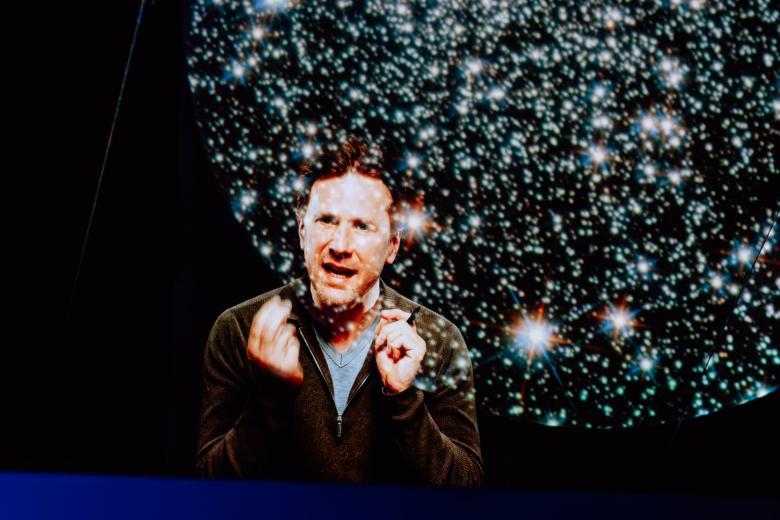An inconvenient truth about antibiotics
Before the discovery of penicillin in 1943, people died from infections caused by everyday household accidents – there were simply no drugs available to fight off these infections. This may happen again in the future, warn scientists from all over the world. Some half a million people worldwide carry a variant of tuberculosis (TB) that can no longer be treated with antibiotics. In the context of European Antibiotic Awareness Day on 18 November, Peter Peters, professor of Nanobiology at UM, talks about his search for a new vaccine.
If TB seems like a thing of the past, in reality it is a problem of the present and the future. The deadliest infection in the world, it causes one and half million deaths annually. Maastricht University’s Professor Peter Peters uses his ultra-powerful microscopes to gain deeper insight into this bacterium, which is threatening Western healthcare with its deviousness: Mycobacterium tuberculosis, the bacterium that causes TB, does not sit still. Just as the ape once evolved into a human and our DNA is still undergoing changes that are passed on to the next generation, the TB bacterium is constantly developing so as to evade antibiotics.
TB in the Netherlands
In recent years, TB strains have emerged that are impervious to most antibiotics (multi-drug-resistant TB, or MDR-TB, which affects half a million people across the globe), if not virtually all drugs (extensively drug-resistant TB, XDR-TB, 50,000 patients). Most cases occur in relatively poor countries, but even within the EU 29,000 new MDR-TB cases are diagnosed annually. “In the Netherlands around 10 cases of MDR-TB are treated per year,” says Peters, “and TB checks cost the country €34 million annually. A spot-check among Syrian refugees in 2015 showed that 11% had TB. These days people travel all over the world, and these bacteria travel with them.”
American action plan
The severity of the problem is becoming increasingly apparent, including among government leaders. In September 2016 all 194 UN member states committed to actively fighting antibiotic-resistant infections, joining forces – just as they have done with climate change – to protect the healthcare of the future.
In December 2015 the US government presented its own action plan to better tackle MDR-TB. ‘If left unchecked,” the report reads, “MDR-TB could erase decades of progress in global TB control.’ While other strains of bacteria tend to be broken down by white blood cells within a few weeks, the TB bacterium – including the resistant strain – remains in the body for many years. It bides its time, waiting for the immune system to offer up a moment of weakness (for instance, due to chemotherapy or immunotherapy) and then it strikes.
Alarm bells
In November 2015, the prestigious journal The Lancet published an article on antibiotic resistance in other bacteria which set alarm bells ringing for Peters and his colleagues. A strain of E. coli had been found in China that is not only resistant to our last resort in antibiotics (Colistin), but that can also transfer this resistance to other bacterial strains, such as Klebsiella and Pseudomonas. “If you have an appendectomy or receive an implant, these are the first bacteria to strike and leave you critically ill. That’s why you get antibiotics before these operations, as a precautionary measure. But if the antibiotics no longer work, you could die – from a simple appendectomy.”
Positive news
But Peters would rather look at the bright side. “We’re trying to address this problem through scientific research. Here in Maastricht we’re working hard on a new vaccine for tuberculosis. The current one is 60 years old and, after all, prevention is better than cure.” As a nanobiologist, he is interested in the tiniest cell particles: proteins and their ‘factories’, including ribosomes. Peters and his research group are mapping out the TB bacterium with microscopes so powerful you could use them to read a newspaper lying on the surface of the moon. They have found a dozen or so proteins protruding from the cell wall in the form of complex needles. “We want to help unravel the 3D structure of those needles so that vaccinologists can develop a vaccine for them. Vaccines for the prevention and treatment of HIV are already being developed using the same method.”
Antibiotics cocktail
The three-drug cocktail for HIV is, in Peters’s view, an example of nanotechnology being put to good use. “The aim is to develop a comparable cocktail of antibiotics that fit into the protein factories. This will prevent a resistant bacterium from multiplying into hundreds of billions of bacteria in the course of a week .”
Peters realises that his is not a pleasant message. He draws the parallel with climate change: just a few years ago, talking about that also amounted to telling an ‘inconvenient truth’. “It took years for people to realise climate change is a serious problem that will affect the whole world, not only the areas that lie below sea level. In the same way, tuberculosis is something that’s happening in our own backyards.”
By Femke Kools
Read more about European Antibiotic Awareness Day.
Watch ‘Struggle to live’ by James Nachtwey on the impact of TB in the world today, and the TED talk by journalist Maryn McKenna ‘What do we do when antibiotics don’t work anymore?’ (both on YouTube).
What can I do?
Lead a healthy life to keep your immune system in good condition, and if you are prescribed antibiotics, be sure the complete the entire course. Just as with the greenhouse effect, the problem is so immense that only international cooperation (and in this case a lot more research) can solve it.
Also read
-
In Kerkrade, you can listen to the invisible universe
UM and Discovery Museum in Kerkrade make the Einstein Telescope understandable for everyone.

-
Maastricht University ranked #3 worldwide and #1 in Europe in 2025 Better World MBA Ranking
We are incredibly proud to share that the MBA programmes of Maastricht University School of Business and Economics’ executive branches, MSM and UMIO, have once again been recognised among the very best sustainable business MBA programmes worldwide. In the 2025 Better World MBA Ranking by Corporate...

-
